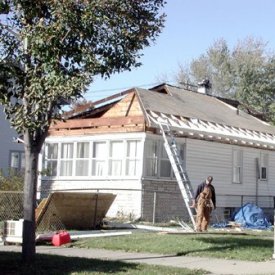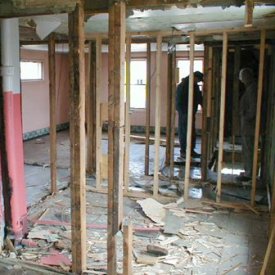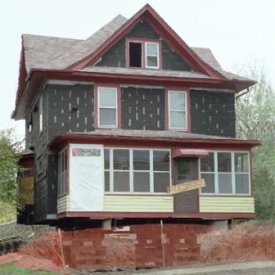April 16, 2003
This study identified best practices for local governments that have decided to become involved in preserving housing. Housing provides shelter, but quality housing also contributes to neighborhood and economic vitality and sustains local tax bases.
Housing strategies will vary from city to city, and each strategy has its own best practices. Local governments should follow best practices in preserving housing, and when they work with others—housing and redevelopment authorities (HRAs), economic development agencies, community action agencies, nonprofit housing organizations, and regional development commissions—they should ensure that best practices are followed.
 |
 |
 |
 |
Recommended Best Practices:
Report Summary:
Preserving housing means keeping residential units safe, livable, and attractive to occupants. Quality housing stock is important not only as shelter but also as a means to long-term neighborhood stability, communities' economic viability, and strong tax bases.
Public sector responses to the need to preserve housing include: property maintenance codes, inspections of rental units, programs requiring inspections before homes are sold, proper administration of the State Building Code, housing information campaigns, and financial subsidies. Not all cities will become involved with preserving housing, but those that do should follow best practices tied to the strategies they select. Although we refer specifically to "cities," counties or others working on local governments' behalf may be involved.
Thinking Strategically
Cities should start by determining their housing needs, if they have not already done so. This involves analyzing information on housing units and factors that affect housing, such as demographic trends. Another best practice is identifying and prioritizing housing needs. Many cities, especially smaller ones, may need to enlist outside expertise to follow these practices.
Cities should also study housing needs and how they relate to other issues in the community. Housing studies should be part of long-term comprehensive and strategic planning processes.
Example: Roseville developed a housing improvement plan that is part of that city's comprehensive plan. The improvement plan, which the city reviews yearly to account for changing market conditions, contains benchmarks for housing activities and describes housing conditions in the city. Together the housing improvement plan and comprehensive plan have guided the city's housing strategies and led to collaborations with housing experts.
Once housing needs are identified, cities should determine appropriate responses to meet them. Involving elected officials in setting housing goals and objectives is a best practice to this end. Another is evaluating a broad range of options and designing strategies to meet housing objectives.
Example: St. Louis Park has designed multiple strategies to meet its housing preservation needs. The city enforces a property maintenance code and requires property owners planning to sell their structures to have them inspected and to correct deficiencies. The city licenses and inspects rental buildings with three or more units. Further, St. Louis Park has partnerships for offering financial assistance and housing preservation information.
As part of deciding on appropriate housing strategies, cities should determine whether they have sufficient internal capacity to implement the strategies or whether they should rely on outside professionals.
Example: Several metropolitan-area cities lacking their own capacity to offer housing information and expertise use the Housing Resource Center, an arm of the nonprofit Greater Metropolitan Housing Corporation. The Center employs construction managers who answer home improvement questions and help residents evaluate contractors' bids. It also administers various financing programs on the cities' behalf.
Garnering elected officials' support is important when determining appropriate housing responses, particularly if local leaders have not been involved previously. A final best practice is to plan for adequate investments in infrastructure such as streets and lighting.
Example: In South St. Paul, the city and the HRA have been involved in activities that form a base of local leader support for housing initiatives. A housing committee, made up of members of the city council, HRA, planning commission, and staff, meets regularly to discuss housing conditions and needs. Plus, strategic planning efforts among city stakeholders led to establishing a common vision for the city's housing.
Implementing Regulatory Strategies
Among housing strategies that communities may choose are regulatory strategies, such as adopting local codes that set standards for property maintenance. Depending on communities' own capacity, implementing such strategies may require outside expertise.
One best practice for administering housing-related codes is to encourage voluntary compliance. When residents comply with the codes on their own, fewer public resources are needed for enforcement. Ways to achieve voluntary compliance include publicizing code requirements, using incentives to reward initial compliance, and offering technical or financial assistance to violators.
Example: Prior to its annual inspections of rental units, Mounds View mails to rental-property owners a list of common code violations as part of the notice that their properties are due for inspection. The list allows owners to fix problems, such as missing smoke detectors or improper clearance to electrical equipment, in advance of inspections, reducing the number of deficiencies and staff time for reinspections.
Jurisdictions should ensure consistent enforcement when administering housing-related codes. Consistency helps avoid charges of discrimination or arbitrariness.
Example: When Cottage Grove implemented a program to inspect rental units, the building official developed an inspection checklist containing 64 items including foundation drainage and venting of plumbing fixtures. Using the checklist ensures that the city holds each building to the same inspection standards.
Administering housing codes also requires enforcement mechanisms with increasingly severe sanctions against noncompliance. A final best practice is to target the housing codes to particular houses or neighborhoods if resources do not allow inspecting all of them.
Example: In Bemidji, the city follows a series of steps when owners do not comply with orders to correct deficiencies identified during inspections of rental housing. The city charges a rental registration fee that covers the first and second inspections, but building owners must pay for each reinspection necessitated by their failure to correct problems. Additional enforcement steps include letters from the city attorney, police citations, and registration revocations. The most serious sanction is property condemnations.
Jurisdictions that administer the State Building Code should follow certain best practices to support housing preservation. Practices such as publicizing code requirements, offering technical assistance, and making the permit process convenient, encourage voluntary compliance. Other best practices are considering compliance alternatives and applying the code consistently.
Example: Each January, the Melrose building official holds a contractor seminar to discuss building code requirements. Because the seminar is accredited by the state, contractors receive professional education credits for attending. The well-attended seminars allow sharing of information among contractors from multiple cities and minimize the times that the building official has to answer the same questions.
Implementing Supportive Strategies
Supportive housing strategies encourage people to preserve their buildings. Providing access to financial assistance is one supportive strategy. For implementation, cities should explore partnerships to attain the expertise and resources needed to deal with complex, multiple financing sources.
Example: The Stevens County HRA applies for and administers housing grants and loans on behalf of cities within the county. In doing so, the HRA works with a city to identify housing needs and then tailors financing plans to meet them. The HRA has experience with federal and state housing programs, and its knowledge benefits the cities, which lack the resources to develop their own housing expertise.
Another best practice tied to offering financial assistance is following management controls to minimize the risks posed by expensive, time-consuming projects. Matching project cost estimates with available financing and inspecting work before paying contractors are examples of these controls. It is also important to identify and communicate with prospective clients.
Example: The Central Minnesota Housing Partnership, a nonprofit housing organization serving 16 counties, takes a "hands on" approach to administering the HOME Rental Rehab program. The Partnership identifies and inspects potentially eligible properties, develops the scope of the work, monitors the work, conducts final inspections, and disburses money to contractors. Its active management role helps it meet program requirements and ensure quality outcomes.
Providing access to housing information and expertise is another strategy that supports housing preservation. Related best practices include: working collaboratively with other organizations, identifying unmet information needs, and tailoring information to meet those needs.
Example: As part of implementing a program to license and improve rental units, the Morris Housing Authority became an information resource for landlords. Besides offering information about the rental program and available rehab financing, the Authority provided a sample damage-deposit form and a checklist to assess rental unit conditions. Offering useful information lessened resistance to the rental licensing program.
Cities or their agents should use a variety of means to communicate housing information. People learn in different ways and are looking for information at different times. Effective housing preservation recognizes and accommodates these differences.
Example: Richfield and the Richfield HRA use many different ways to communicate housing-improvement information to residents. Written materials include a remodeling planbook, a contractor referral list, and numerous tip sheets on topics such as how to secure bids from contractors. The HRA offers the services of a Remodeling Advisor, who meets with homeowners to discuss renovation options. Richfield sponsors an annual remodeling fair, and it publicizes housing information using the city newsletter, Web site, and utility bill inserts.
Some communities' housing may need direct repair and rehabilitation services, such as weatherization or acquiring and rehabilitating rundown properties for resale. Best practices vary by the service but cover program planning, implementation, and marketing.
Example: For decades, Semcac, a community action agency in southeast Minnesota, has offered weatherization services to qualifying households. Semcac's rehabilitation specialists conduct energy audits. Its work crews insulate and weather-strip eligible homes and clean and tune a home's furnace when necessary. Crews are familiar with the agency's other housing preservation programs and refer eligible property owners to them.
Finally, cities should periodically review their strategies to determine how well housing objectives are met. Effective evaluation reveals whether to modify or discontinue a strategy.
More Information
The Program Evaluation Division was directed to conduct this study by the Legislative Audit Commission in April 2002. For a copy of the full report, entitled "Preserving Housing: A Best Practices Review (03-05)", 98 pp., published in April 2003, please call 651/296-4708, e-mail Legislative.Auditor@state.mn.us, write to Office of the Legislative Auditor, Room 140, 658 Cedar St., St. Paul, MN 55155, or go to the webpage featuring the report. Staff who worked on this project were Jody Hauer (project manager), Carrie Meyerhoff, and Lori Sakk.